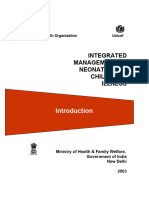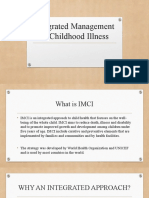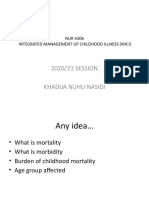Integrated Management of Childhood Illness
Integrated Management of Childhood Illness
Uploaded by
heartianeCopyright:
Available Formats
Integrated Management of Childhood Illness
Integrated Management of Childhood Illness
Uploaded by
heartianeCopyright
Available Formats
Share this document
Did you find this document useful?
Is this content inappropriate?
Copyright:
Available Formats
Integrated Management of Childhood Illness
Integrated Management of Childhood Illness
Uploaded by
heartianeCopyright:
Available Formats
Integrated Management of Childhood Illness (IMCI)
Print Email PDF
One million children under five years old die each year in less developed countries. Just five diseases (pneumonia, diarrhea, malaria, measles and dengue hemorrhagic fever) account for nearly half of these deaths and malnutrition is often the underlying condition. Effective and affordable interventions to address these common conditions exist but they do not yet reach the populations most in need, the young and impoverish. The Integrated Management of Childhood Illness strategy has been introduced in an increasing number of countries in the region since 1995. IMCI is a major strategy for child survival, healthy growth and development and is based on the combined delivery of essential interventions at community, health facility and health systems levels. IMCI includes elements of prevention as well as curative and addresses the most common conditions that affect young children. The strategy was developed by the World Health Organization (WHO) and United Nations Childrens Fund (UNICEF). In the Philippines, IMCI was started on a pilot basis in 1996, thereafter more health workers and hospital staff were capacitated to implement the strategy at the frontline level. Objectives of IMCI
Reduce death and frequency and severity of illness and disability, and Contribute to improved growth and development
Components of IMCI
Improving case management skills of health workers 11-day Basic Course for RHMs, PHNs and MOHs 5 - day Facilitators course 5 day Follow-up course for IMCI Supervisors
Improving over-all health systems Improving family and community health practices
Rationale for an integrated approach in the management of sick children Majority of these deaths are caused by 5 preventable and treatable conditions namely: pneumonia, diarrhea, malaria, measles and malnutrition. Three (3) out of four (4) episodes of childhood illness are caused by these five conditions
Most children have more than one illness at one time. This overlap means that a single diagnosis may not be possible or appropriate. Who are the children covered by the IMCI protocol? Sick children birth up to 2 months (Sick Young Infant) Sick children 2 months up to 5 years old (Sick child) Strategies/Principles of IMCI
All sick children aged 2 months up to 5 years are examined for GENERAL DANGER signs and all Sick Young Infants Birth up to 2 months are examined for VERY SEVERE DISEASE AND LOCAL BACTERIAL INFECTION. These signs indicate immediate referral or admission to hospital
The children and infants are then assessed for main symptoms. For sick children, the main symptoms include: cough or difficulty breathing, diarrhea, fever and ear infection. For sick young infants, local bacterial infection, diarrhea and jaundice. All sick children are routinely assessed for nutritional, immunization and deworming status and for other problems
Only a limited number of clinical signs are used A combination of individual signs leads to a childs classification within one or more symptom groups rather than a diagnosis.
IMCI management procedures use limited number of essential drugs and encourage active participation of caretakers in the treatment of children
Counseling of caretakers on home care, correct feeding and giving of fluids, and when to return to clinic is an essential component of IMCI
BASIS FOR CLASSIFYING THE CHILDS ILLNESS (please see enclosed portion of the IMCI Chartbooklet) The childs illness is classified based on a color-coded triage system: PINK- indicates urgent hospital referral or admission YELLOW- indicates initiation of specific Outpatient Treatment GREEN indicates supportive home care Steps of the IMCI Case management Process The following is the flow of the iMCI process. At the out-patient health facility, the health worker should routinely do basic demographic data collection, vital signs taking, and asking the mother about the child's problems. Determine whether this is an initial or a follow-up visit. The health worker then proceeds with the IMCI process by checking for general danger signs, assessing the main symptoms and other processes indicated in the chart below. Take note that for the pink box, referral facility includes district, provincial and tertiary hospitals. Once admitted, the hospital protocol is used in the management of the sick child. THE INTEGRATED CASE MANAGEMENT PROCESS
Program Manager: Ms. Elizabeth M. Joven Department of Health - National Center for Disease Prevention and Control (DOH-NCDPC) Contact Number: 651-7800 local 1726-1730 Email: beth3joven@yahoo.com
2111 reads
Follow DOH
You might also like
- EPI - AND - IMCI - Docx Filename - UTF-8''EPI AND IMCIDocument14 pagesEPI - AND - IMCI - Docx Filename - UTF-8''EPI AND IMCIYvonne Carmel Aguilar SunigaNo ratings yet
- CHN 211 Week 8 PPT - Integrated Management of Childhood IllnessDocument82 pagesCHN 211 Week 8 PPT - Integrated Management of Childhood IllnessMark Angelo Berdejo100% (1)
- IMCI - Integrated Management of Childhood IllnessDocument11 pagesIMCI - Integrated Management of Childhood IllnessIvy100% (2)
- Childhood Obesity: Causes and Consequences, Prevention and Management.From EverandChildhood Obesity: Causes and Consequences, Prevention and Management.No ratings yet
- Integrated Management On Childhood IllnessDocument3 pagesIntegrated Management On Childhood IllnessAbeer AguamNo ratings yet
- Pediatric Revieer PrelimsDocument3 pagesPediatric Revieer PrelimsJada GonzalesNo ratings yet
- Integrated Management of Childhood IllnessDocument18 pagesIntegrated Management of Childhood IllnessRika Mae100% (1)
- MCN Lecture NotesDocument52 pagesMCN Lecture NotesJHYANE KYLA TRILLESNo ratings yet
- Integrated Management of Childhood IllnessesDocument27 pagesIntegrated Management of Childhood IllnessesJoeYeshitellaNo ratings yet
- IMCIDocument11 pagesIMCIJoshua Villarba100% (1)
- IMCI IntroductionDocument7 pagesIMCI IntroductionVanessa MendezNo ratings yet
- Pediatric HUDocument2 pagesPediatric HUEmee Rose DangcalanNo ratings yet
- IMNCI COMBINED + AdolescenceDocument82 pagesIMNCI COMBINED + AdolescenceibegbunamchinemeremNo ratings yet
- Module 1Document16 pagesModule 1devikanika02No ratings yet
- Imci, Diseases With TreatmentDocument54 pagesImci, Diseases With TreatmentBernadeth Tolentino LimonNo ratings yet
- Integrated Management of Childhood IllnessDocument2 pagesIntegrated Management of Childhood Illness지창욱No ratings yet
- Report of Inservice EducationDocument35 pagesReport of Inservice EducationAkansha JohnNo ratings yet
- Integrated Management of Childhood IllnessDocument5 pagesIntegrated Management of Childhood Illnessjulieyauder624No ratings yet
- IMNCI Training Module 1-9Document356 pagesIMNCI Training Module 1-9smbawasaini60% (5)
- 7091371954mod 1 INTRODUCTION RDocument16 pages7091371954mod 1 INTRODUCTION RJEEJANo ratings yet
- Integrated Management of Childhood IllnessDocument8 pagesIntegrated Management of Childhood IllnessSehar162No ratings yet
- Integrated Management of Neonatal and Childhood Illness Strategy An Approach For Hypothermia in NewbornsDocument5 pagesIntegrated Management of Neonatal and Childhood Illness Strategy An Approach For Hypothermia in NewbornsEditor IJTSRDNo ratings yet
- About Integrated Management of Childhood IllnessDocument5 pagesAbout Integrated Management of Childhood IllnessRouena Santiago VillaramaNo ratings yet
- Weekly Activity Midterm CHN (Vivas, Mariah Jamby A. BSN-II)Document5 pagesWeekly Activity Midterm CHN (Vivas, Mariah Jamby A. BSN-II)Mariah VivasNo ratings yet
- Doh Health Programs 1Document139 pagesDoh Health Programs 1Eric VeranoNo ratings yet
- Lesson 2 Integrated Management of Childhood Illness (Imci)Document6 pagesLesson 2 Integrated Management of Childhood Illness (Imci)JAMES ROD MARINDUQUENo ratings yet
- Integrated Management of Childhood IllnessDocument13 pagesIntegrated Management of Childhood IllnessRachelle Gay PacialNo ratings yet
- IMCI (Integrated Management of Childhood Illness)Document4 pagesIMCI (Integrated Management of Childhood Illness)Jane BautistaNo ratings yet
- Integrated Management of Childhood Illness (Course Audit)Document285 pagesIntegrated Management of Childhood Illness (Course Audit)MOHAMMAD IBRAHIM AGORNo ratings yet
- Pedia ImciDocument2 pagesPedia ImciWispy NotesNo ratings yet
- Integrated Management of Childhood Illness (IMCI)Document10 pagesIntegrated Management of Childhood Illness (IMCI)Najia Sajjad KhanNo ratings yet
- IMNCIDocument31 pagesIMNCIJaya Prabha100% (2)
- S1 IntroductionDocument17 pagesS1 IntroductionBelay GezahegnNo ratings yet
- IMCIDocument15 pagesIMCISandy JusiNo ratings yet
- SEMINAR ON ImnciDocument8 pagesSEMINAR ON Imncivineeta.ashoknagar100% (1)
- Integrated Management of Neonatal & Childhood Illness (Imnci)Document5 pagesIntegrated Management of Neonatal & Childhood Illness (Imnci)J Ta RaNo ratings yet
- SEMIDocument17 pagesSEMISophia Nicole AranasNo ratings yet
- 1-Imci 48Document48 pages1-Imci 48Abdikadir MohamedNo ratings yet
- 1 IMCI IntroductionDocument13 pages1 IMCI IntroductionESTE CRECIA EDULLANTES BULLECERNo ratings yet
- Joaquim Pinto, Lic - SP, M.M, M.MTSC, DR. Lidia Gomes SKM, MPH, Dr. Avelino Guterres Correia, MPH, Ministry of Health of Timor-LesteDocument7 pagesJoaquim Pinto, Lic - SP, M.M, M.MTSC, DR. Lidia Gomes SKM, MPH, Dr. Avelino Guterres Correia, MPH, Ministry of Health of Timor-LesteInternational Journal of Innovative Science and Research Technology100% (1)
- Why Do We Need To Adopt The I.M.C.I. Approach or The Integrated Management of Childhood Illness in The Philippines ?Document15 pagesWhy Do We Need To Adopt The I.M.C.I. Approach or The Integrated Management of Childhood Illness in The Philippines ?Mae DoctoleroNo ratings yet
- ImnciDocument8 pagesImnciSwati LalNo ratings yet
- INTEGRATED MANAGEMENT OF NEONATE AND CHILDHOOD ILLNESS (Repaired)Document13 pagesINTEGRATED MANAGEMENT OF NEONATE AND CHILDHOOD ILLNESS (Repaired)Archana Sahu100% (2)
- WHO - IMCI-Integrated Management of Childhood IllnessDocument60 pagesWHO - IMCI-Integrated Management of Childhood Illnesseric100% (1)
- IMCIDocument85 pagesIMCIPiao Liang JingNo ratings yet
- IMCIDocument24 pagesIMCISaniNo ratings yet
- In The Pre-Hospital SettingDocument13 pagesIn The Pre-Hospital SettingMichael VillavertNo ratings yet
- Integrated Management of Childhood Illness (IMCI)Document48 pagesIntegrated Management of Childhood Illness (IMCI)Ram krishnaNo ratings yet
- 12, IMNCI NewDocument280 pages12, IMNCI NewEsayas NashaNo ratings yet
- Seminar On IMNCI (Autosaved)Document17 pagesSeminar On IMNCI (Autosaved)CM-A-12-Aditya Bhopalbade100% (3)
- 6 Chapter 4 CHNDocument50 pages6 Chapter 4 CHNPABLO, JACKSON P.No ratings yet
- IMNCI Part - IDocument72 pagesIMNCI Part - IKedir AhmedNo ratings yet
- Integrated Management of Childhood IllnessDocument83 pagesIntegrated Management of Childhood Illnessjava_biscocho1229No ratings yet
- HEALTH Written ReportDocument6 pagesHEALTH Written ReportChristine Angelica EvangelistaNo ratings yet
- 1 MDW 204 Imci Integrated Management of Childhood IllnessDocument11 pages1 MDW 204 Imci Integrated Management of Childhood IllnessMaria Lejani TerencioNo ratings yet
- IMCI#1Document89 pagesIMCI#1Rosechelle Baggao Siupan-ElarcoNo ratings yet
- ImciDocument27 pagesImciRosalyn Marie Morales SugayNo ratings yet
- Integrated Management of Childhood IllnessDocument3 pagesIntegrated Management of Childhood IllnessJanine Alexis BuenviajeNo ratings yet



























































